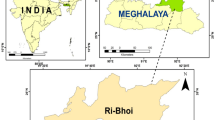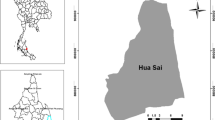Abstract
Forest fires constitute a foremost environmental calamity that distresses the sustainability of the forest. The main source of degradation of Jharkhand forests are forest fires conquered by forest species of Sal and Bamboo. Palamau Tiger Reserve in Jharkhand state, India, is becoming more susceptible to forest fire due to anthropogenic disturbance coupled with speedy upsurge in population. In this study, forest fire risk in PTR was evaluated based on various fire inducing factors, viz., forest fuel, settlements, roads, bare soil index, elevation slope and aspect. Geoinformatics based multi-criteria decision analysis (MCDA) through method of AHP (analytic hierarchy process) used to extract forest fire risk map in five classes: Very low risk, low risk, moderate risk, high risk and very high risk. The results obtained showed that about 180 km2 (14.85%) falls under very low fire risk zone, 234 km2 (19.30%) falls in low fire risk zone, 269.73 km2 (22.16%) falls under moderate fire risk zone, 299.36 km2 (24.59%) falls under high fire risk zone and 232.56 km2 (19.10%) falls in very high fire risk zone. Forest fire risk map was validated from historical fire incidents observed through field data, MODIS and SNPP-VIIRS satellite products. The results showed that the geoinformatics based forest fire risk zones delineated through MCDA-AHP method are in good agreement with historical forest fire occurrences, henceforth may be utilised for fire planning for mitigation in forest areas.
Research Highlights
-
PTR is becoming more susceptible to forest fire due to anthropogenic disturbance coupled with speedy upsurge in population.
-
Forest Fires Risk was evaluated based on various fire inducing factors viz., forest fuel, settlements, roads, bare soil index, elevation slope and aspect through method of AHP.
-
Forest fire risk map was validated from historical fire incidents observed through field data, MODIS and SNPP-VIIRS satellite products.
-
The results showed that the geoinformatics based forest fire risk zones are in good agreement with historical forest fire occurrences henceforth may be utilised for fire planning for mitigation in forest areas.











Similar content being viewed by others
Abbreviations
- MCDA:
-
Multi-criteria decision analysis
- AHP:
-
Analytic hierarchy process
- PTR:
-
Palamau Tiger Reserve
- ASL:
-
Above sea level
- FFRI:
-
Forest fire risk index
- WSM:
-
Weighted-sum-method
- CR:
-
Consistency ratio
- RCI:
-
Random consistency index
- RI:
-
Consistency index
- BI:
-
Bare soil index
- DEM:
-
Digital elevation model
- DPAP:
-
Drought prone areas programme
References
Arienti M C, Cumming S G, Krawchuk M A and Boutin S 2009 Road network density correlated with increased lightning fire incidence in the Canadian western Boreal forest; Int. J. Wildland Fire 18(8) 970–982, https://doi.org/10.1071/WF08011.
Bilgili E 2003 Stand development and fire behavior; Forest Ecol. Manag. 179 333–339.
Bilici E 2009 A study on the integration of firebreaks and fireline with forest roads networks and it’s planning and construction (a case study of Gallipoly National Park) Istanbul University; Fac. Forestry J. Ser. A 59(2) 86–102.
Carmel Y, Paz S, Jahashan F and Shoshany M 2009 Assessing fire risk using Monte Carlo simulations of fire spread; Forest Ecol. Manag. 257(1) 370–377.
Champion H G and Seth S K 1968 Revised Forest Types of India, Government of India, New Delhi, 404p.
Chavan, M E, Das K K and Suryawanshi R S 2012 Forest fire risk zonation using remote sensing and GIS in Huynial watershed; Tehri Garhwal district, UA; Int. J. Basic Appl. Res 2 6–12.
Chuvieco E (ed.) 2008 Satellite observation of biomass burning: Implications in global change research; In: Earth Observation and Global Change, pp. 109–142.
Coulter E D, Coakley J and Sessions J 2006 The analytic hierarchy process: A tutorial for use in prioritizing forest road investments to minimize environmental effects; Int. J. Forest Eng. 17(2) 51–69.
Demir M, Kucukosmanoglu A, Hasdemir M, Ozturk T and Acar H H 2009 Assessment of forest roads and firebreaks in Turkey; African J. Biotechnol. 8(18) 4553–4561.
Díaz-Delgado R, Lloret F and Pons X 2004 Spatial patterns of fire occurrence in Catalonia, NE Spain; Landsc. Ecol. 19 731–745.
El Baba M Kayastha P and De Smedt F 2014 Landfill site selection using multi-criteria evaluation in the GIS interface: A case study from the Gaza Strip, Palestine; Arabian J. Geosci. 8(9), https://doi.org/10.1007/s12517-014-1736-9.
Erden T and Coskun M Z 2010 Multi-criteria site selection for fire services: The interaction with analytic hierarchy process and geographic information systems; Nat. Hazards Earth Syst. Sci. 10 2127–2134.
Erten E, Kurgun V and Musao N 2004 Forest fire risk zone mapping from satellite imagery and GIS a case study; In: Proceedings of the XXth ISPRS Congress, Istanbul, Turkey, 12–23 July 2004, pp. 33–39.
Eugenio F C and dos Santos A R 2016 Applying GIS to develop a model for forest fire risk: A case study in Espírito Santo, Brazil; J. Environ. Manag. 173 65–71.
FSI 2015 http://fsi.nic.in/isfr-2015/isfr-2015-executive-summary.pdf.
Gao X, Fei X and Xie H 2011 Forest fire risk zone evaluation based on high spatial resolution RS image in Liangyungang Huaguo Mountain Scenic Spot; IEEE International Conference on Spatial Data Mining and Geographical Knowledge Services. Fuzhou, China.
Gazzard R 2012 Risk Management Control Measure: Toolkit for Practitioners and Advisors; UK Vegetation Fire Risk Management, 24p.
Guido R, Van derr Werf J T, Randerson G, James Collatz L, Giglio P S and Kasibhatla A F 2004 Continental-scale partitioning of fire emissions during the 1997–2001 El Nino/La Nina period; Science 303 73–76.
Gülci N 2014 Researches on precision forestry in forest planning. Ph.D. thesis, KSU, Kahramanmaraş, 264p.
Habibi K, Lotfi S and Koohsari M J 2008 Spatial analysis of urban fire station locations by integrating AHP model and IO logic using GIS: A case study of zone 6 of Tehran; J. Appl. Sci. 8(19) 3302e15.
Jaiswal R K, Mukherjee S, Raju K D and Saxena R 2002 Forest fire risk zone mapping from satellite imagery and GIS; Int. J. Appl. Earth Obser. Geoinfor. 4(1) 1–10.
Kanga S, Sharma L K, Pandey P C, Nathawat M S and Sharma S K 2013 Forest fire modeling to evaluate potential hazards to tourism sites using geospatial approach; J. Geomat. 7 93–99.
Kayastha P, Dhital M R and De Smedt F 2013 Application of the analytical hierarchy process (AHP) for landslide susceptibility mapping: A case study from the Tinau watershed, west Nepal; Comput. Geosci. 52 398–408.
Kumari B and Pandey A C 2019 MODIS based forest fire hotspot analysis and its relationship with climatic variables; Spat. Inf. Res., https://doi.org/10.1007/s41324-019-00275-z.
Kumari B, Pandey A C and Kumar A 2020 Remote Sensing approach to evaluate anthropogenic influences on Forest Cover of Palamau Tiger Reserve, Eastern India; Ecol. Process. 9(17), https://doi.org/10.1186/s13717-020-0219-z.
Lai W, Han-Lun L, Qi L, Jing-Yi C and Yi-Jiao C 2011 Study and implementation of fire sites planning based on GIS and AHP; Proc. Eng. 11 486e95.
Lin J and Sergio R 2009 A derivation of the statistical characteristics of forest fires; Ecol. Model. 220 898–903.
Loepfe L, Lloret F and Roman-Cuesta R M 2011 Comparison of burnt area estimates derived from satellite products and national statistics in Europe; Int. J. Remote Sens. 33 3653–3671.
Long N T and De Smedt F 2012 Application of an analytical hierarchical process approach for landslide susceptibility mapping in A Luoi district, Thua Thien Hue Province, Vietnam; Environ. Earth Sci. 66 1739–1752.
Mahdavi A, Shamsi S R F and Nazari R 2012 Forests and rangelands’ wildfire risk zoning using GIS and AHP techniques; Casp. J. Environ. Sci. 10 43–52.
Malczewski J, Moreno-Sanchez R, Bojórquez-Tapia L A and Ongay-Delhumeau E 1997 Multicriteria group decision making model for environmental conflict analysis in the Cape Region, Mexico; J. Environ. Plan. Manag. 40 349–374.
Mohammadi F, Shabanian N, Pourhashemi M and Fatehi P 2010 Risk zone mapping of forest fire using GIS and AHP in a part of Paveh Forests; IJFPR 18(4) 569–586.
Ramanathan R 2001 A note on the use of the analytic hierarchy process for environmental impact assessment; J. Environ. Manag 63 27–35.
Rikimaru A, Roy P S and Miyatake S 2002 Tropical forest cover density mapping; Int. Soc. Trop. Ecol. 43(1) 39–47 (ISSN 0564-3295).
Roy P S 2003 Forest fire and degradation assessment using satellite remote sensing and geographic information system fire and degradation assessment using satellite remote sensing and geographic information system; In: Satellite Remote Sensing and GIS Applications in Agricultural Meteorology (eds) Sivakumar M V K, Roy P S, Harmsen K and Saha S K, Proceedings of a Training Workshop, 7–11 July 2003 in Dehra Dun, India, pp. 361–400.
Saaty T L 1977 A scaling method for priorities in hierarchical structures; J. Math. Psychol.
Saaty T L 1980 The Analytic Hierarchy Process: Planning, Priority Setting, Resource Allocation; McGraw-Hill Book Co.: New York, NY, USA, 287p.
Sağlam B, Bilgili E, Durmaz B D, Küçük Ö, Kadıoğulları A İ and Küçük Ö 2008 Spatio-temporal analysis of forest fire risk and danger using LANDSAT imagery; Sensors 8 3970–3987.
Srivanit M 2011 Community risk assessment: Spatial patterns and GIS-based model for fire risk assessment – A case study of Chiang Mai Municipality; J. Archit. Plan. Res. Stud. 8 113–126.
Thompson M P, Haas J R, Gilbertson-day J W, Scott J H, Langowski P, Bowne E and Calkin D E 2015 Development and application of a geospatial wild fire exposure and risk calculation tool; Environ. Model. Softw. 63 61–72.
Xiaowei L and Gang Z 2014 A comparison of forest fire indices for predicting fire risk in contrasting climates in China; Nat. Hazards 70 1339–1356.
Acknowledgements
We thank Central University of Jharkhand for all the vital assistance and support. We are also grateful to Forest Department, Jharkhand for providing the essential information and data about the study area, i.e., Palamau Tiger Reserve, Jharkhand.
Author information
Authors and Affiliations
Contributions
Binita Kumari wrote the manuscript with comments from Arvind Chandra Pandey. Binita Kumari has developed the ideas and framework for the manuscript.
Corresponding author
Additional information
Communicated by N V Chalapathi Rao
Rights and permissions
About this article
Cite this article
Kumari, B., Pandey, A.C. Geo-informatics based multi-criteria decision analysis (MCDA) through analytic hierarchy process (AHP) for forest fire risk mapping in Palamau Tiger Reserve, Jharkhand state, India. J Earth Syst Sci 129, 204 (2020). https://doi.org/10.1007/s12040-020-01461-6
Received:
Revised:
Accepted:
Published:
DOI: https://doi.org/10.1007/s12040-020-01461-6




